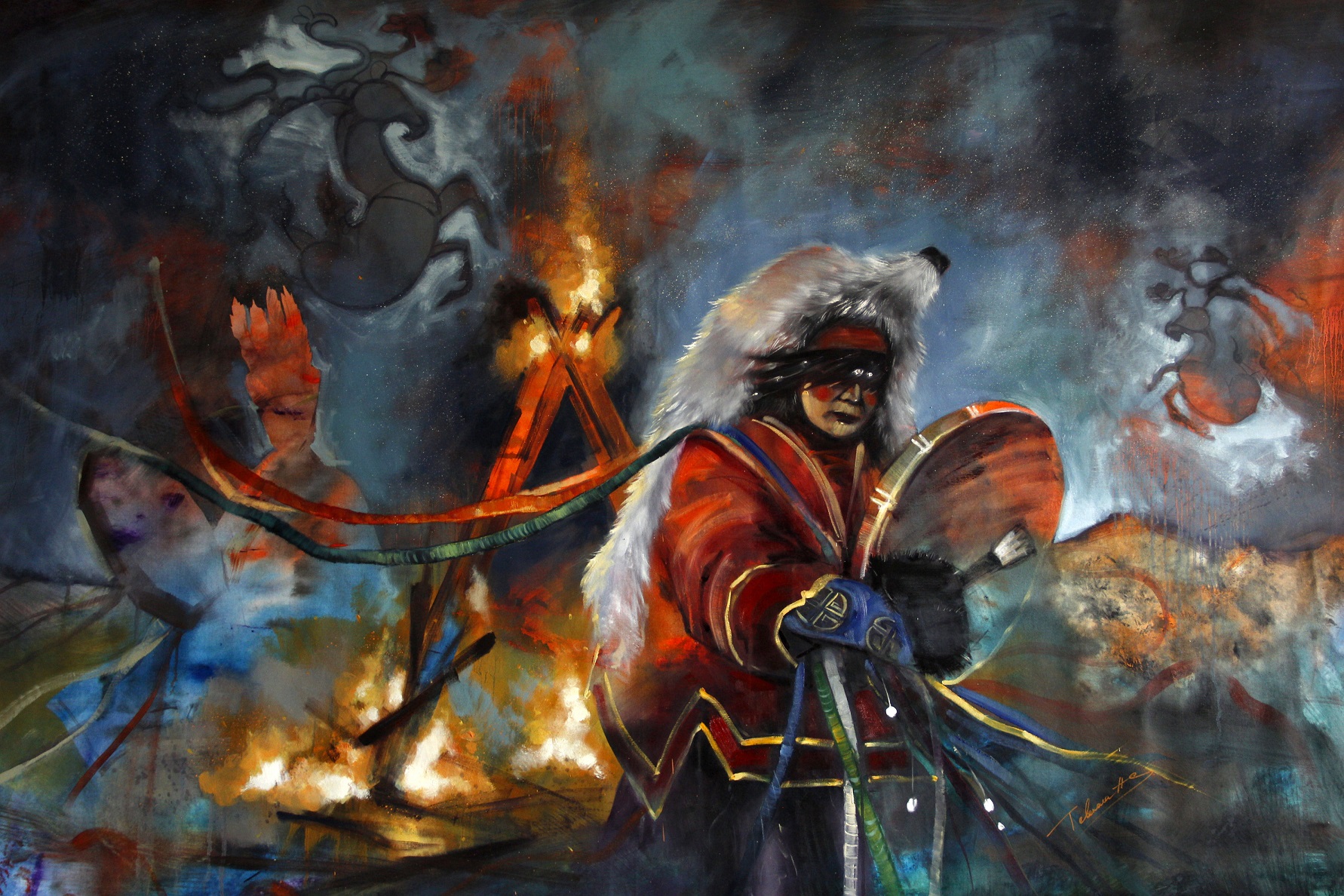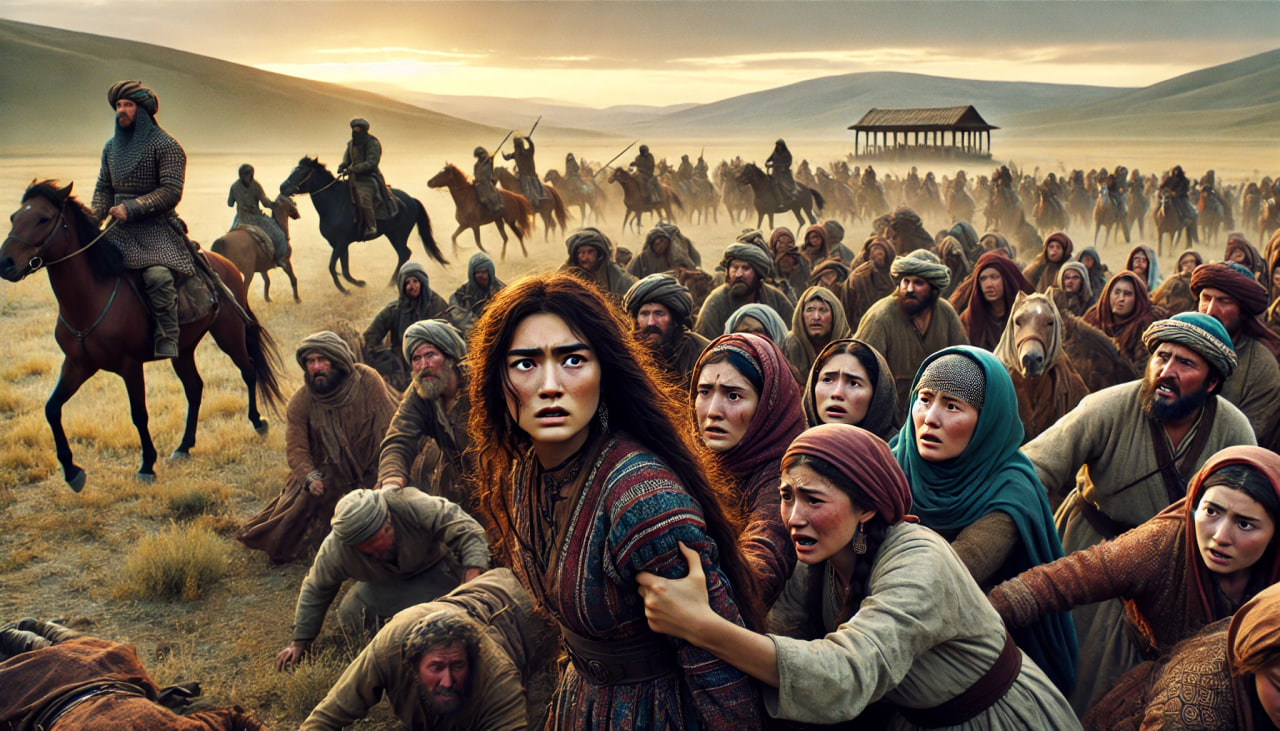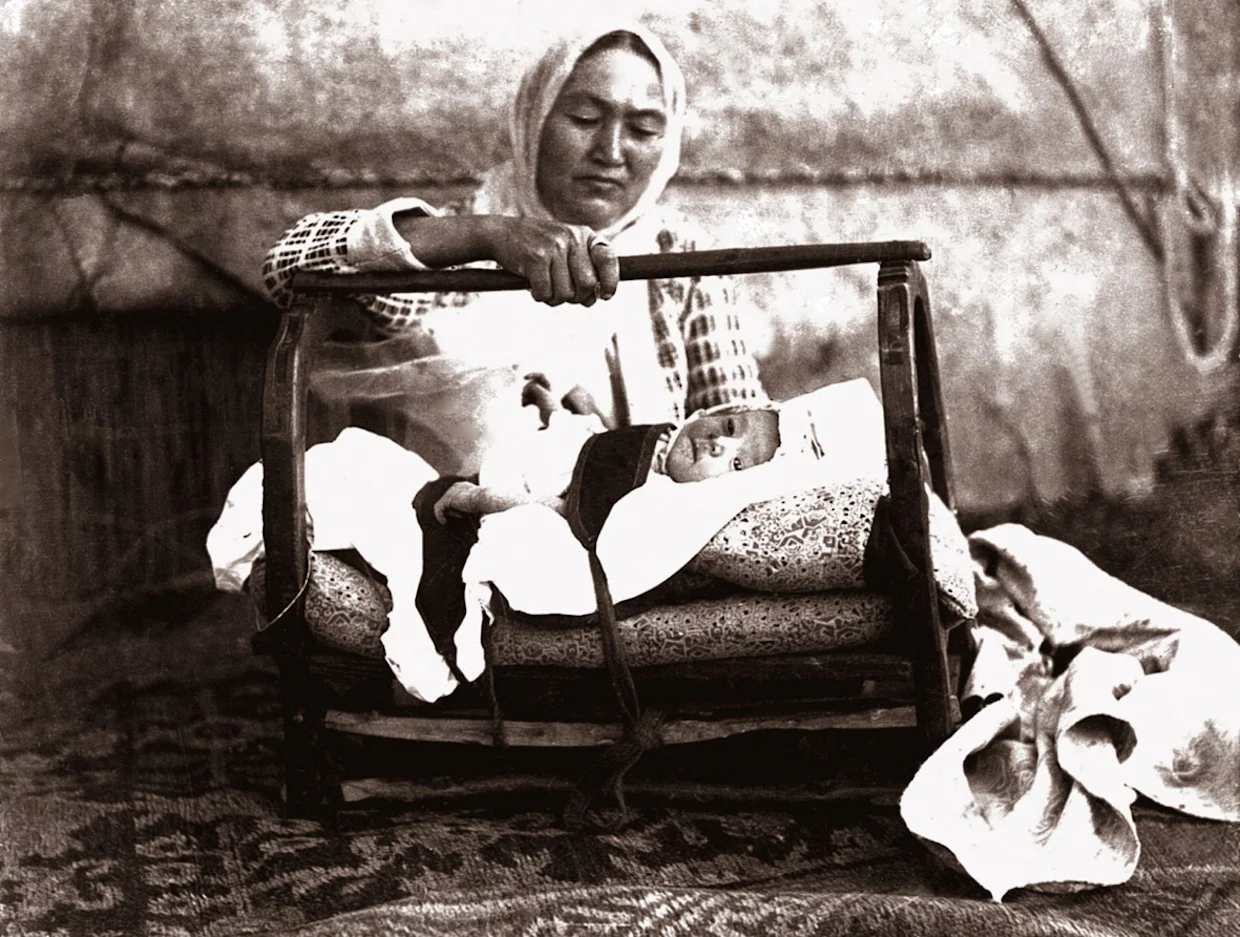
Lullaby. The first half of the XX century. Photo by D. Bagaev.
A FEMINIST WARRIOR
Father, will I be born?
Be born, the light of my life.
Only if I have control over myself will I come into this world; but why should I be born if you don't grant me such power?
You will have complete control over your actions and be your own mistress.
This rather unusual dialogue between a man and his to-be-born daughter is quoted from the fairy tale ‘A Girl Called Dudar’. Typically, even if a Kazakh fairy tale is named after a girl, her role tends to be passive. However, in this tale, the main heroine, Dudar, emerges as a warrior maiden who is inherently stronger than any man. Yet, when she marries—whether by choice or against her will—she finds herself fleeing from a werewolf or an old woman named Mystan. It turns out that the desire she expressed at birth, to wield power over her own life, is a fundamental condition. This fairy tale diverges so significantly from other Kazakh tales that one might wonder if it could be a feminist joke. Yet, the tale was recorded and published by the Turkologist V. Radlov as early as 1870. Some of its most ‘unusual’ motifs in Kazakh folklore align it with the folk traditions of Siberian Turkic peoples, thus firmly embedding it in our cultural heritage.
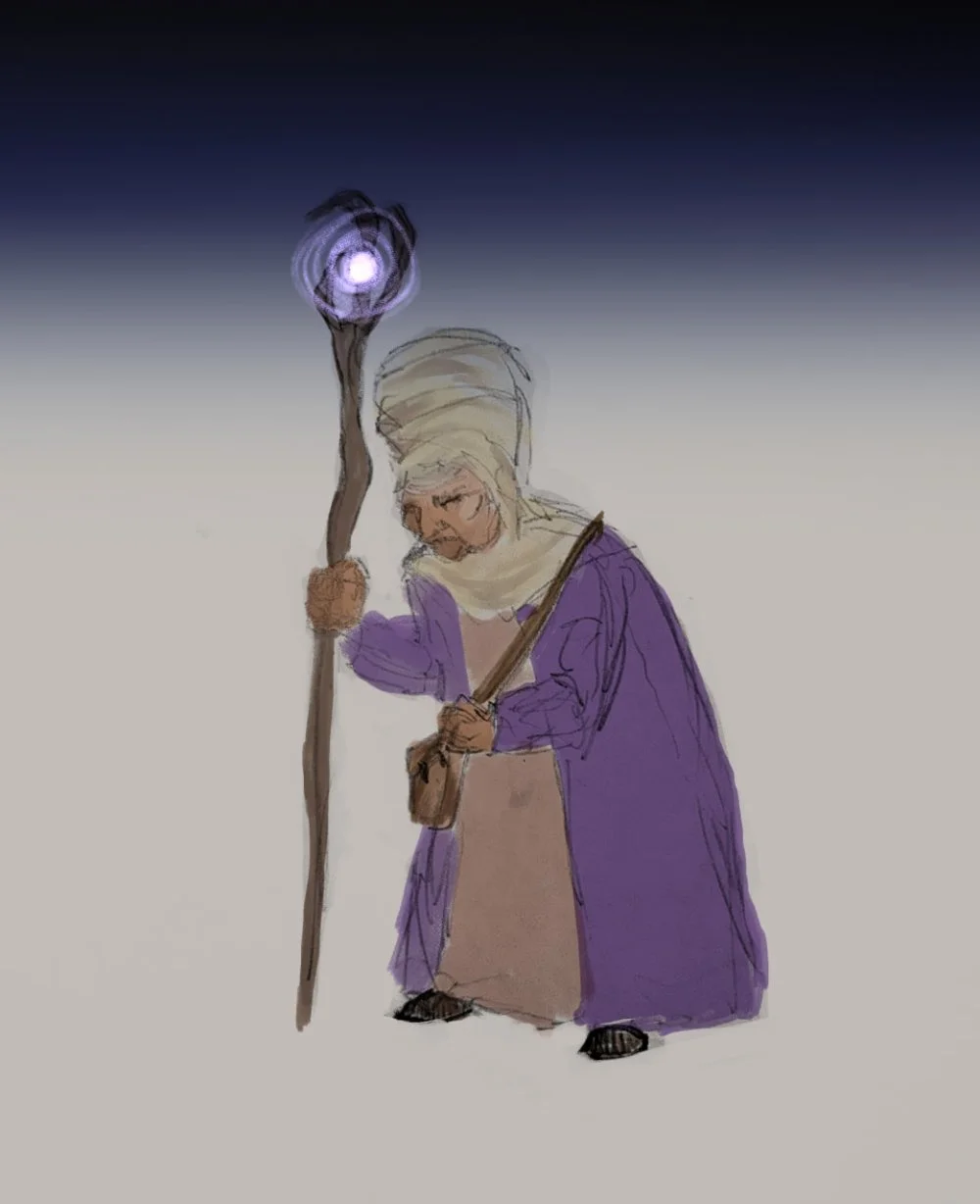
Old Mystan/Beisembay Akzel/Qalam
HOW COWARDLY HEROES ARE BORN
The protagonist of the fairy tale ‘Batyr Alibek’, like Dudar and many other prominent figures in Kazakh fairy tales and epics, was born as a result of his childless, elderly parents praying for a child during a pilgrimage to holy places. In many such stories, the pregnant woman develops a passionate craving for something exotic and tabooed in ordinary life, a motif known as jerik bolu and connected with totemism (more about the topic is available in my book The Eternal Sky of the Kazakhs). For instance, Alpamys's mother consumes the heart of a wolf, and her son inherits wolf-like traits (börizat); Qobylandy'si
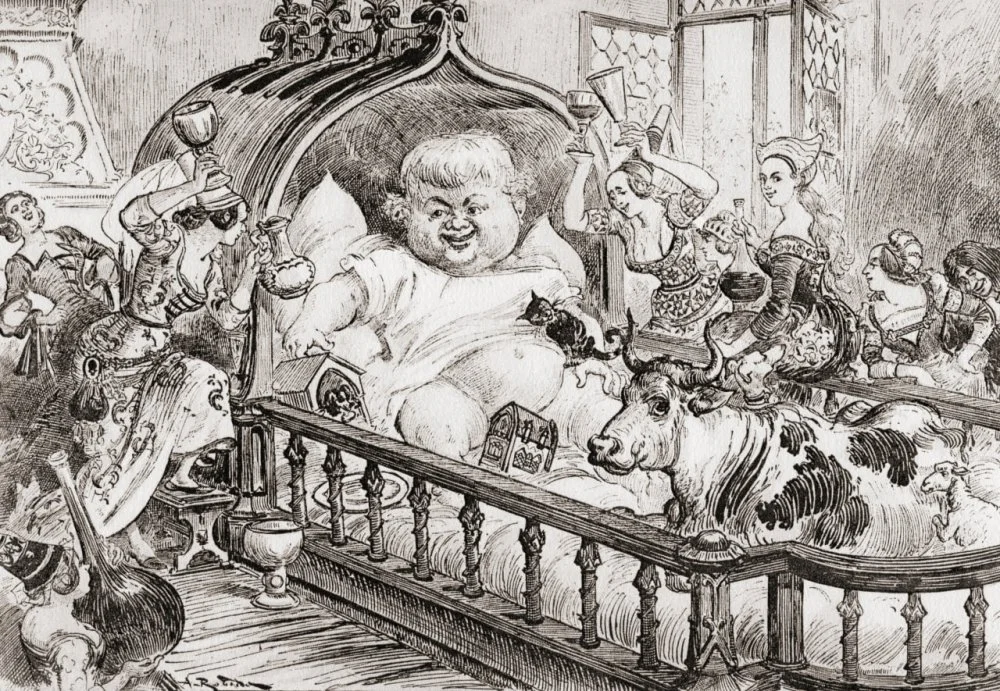
After the illustration by Albert Robida for Gargantua and Pantagruel by François Rabelais. Gargantua in the Cradle/Alamy
Indeed, such a pregnancy concludes in a Rabelaisian manner. When the woman's water breaks, it floods a sixty-rope yurt (though, this is clearly an exaggeration because such a dwelling would have an area of about 500 square meters). Those gathered to assist in the birth navigate their way around the yurt in their overturned skullcap-kasaba hats, paddling with their earrings as makeshift oars. When Alibek's head finally emerges, a woman slaps the newborn, exclaiming, ‘You've caused trouble even before birth; what good can we expect from you after birth?’ The baby then seemingly retreats back into the womb. Several days later, the pregnant woman goes into labor again, eventually giving birth to Alibek and his two sisters. Naturally, Alibek is born a giant: he is wrapped in the skins of sixty sheep, with the swaddling barely reaching his ankles, gripping his double-edged sword in hand—an ancient mythological motif. This tale seems to be a fragment of a forgotten mythic epic or astral myth. Interestingly, this crucial detail—the double-edged sword—is never fully revealed, and the main hero's name likely underwent changes over time, which is apparent against the background of other characters’ very archaic names.
What's intriguing is that despite being born in such a miraculous manner, the mighty hero doesn't always behave heroically. Alibek and his sisters face a threat from Batyr Şülengır.i
Alibek sets off to find his betrothed Aqbilek and learns that Dev Jekeşunaqi
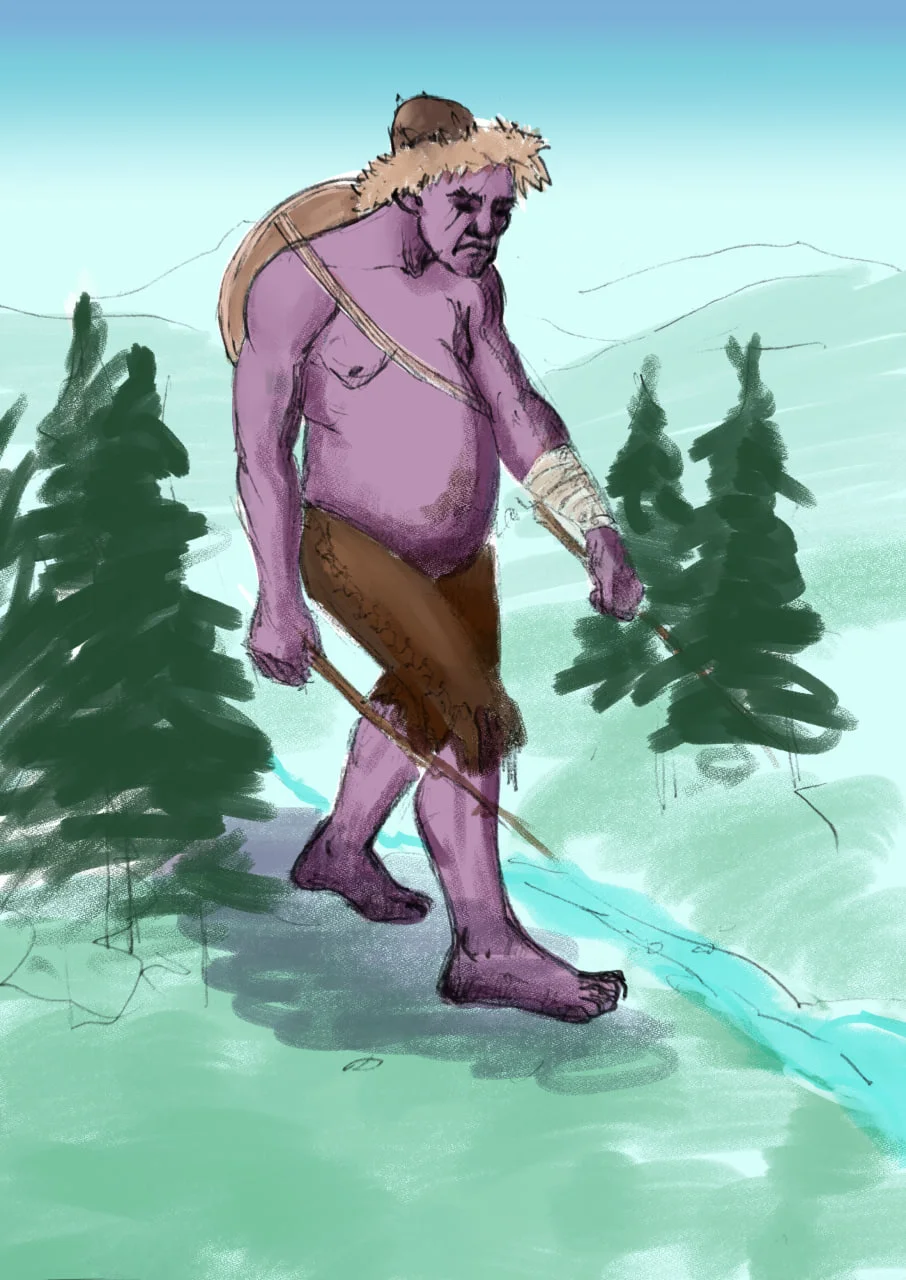
Dau/Beisembay Akzel/Qalam
Regarding the theme of birth, it's noteworthy how the hero, born only on the second attempt, initially seeks to avoid confrontation with his enemy, resorting to fleeing and risking dishonor. Only when he is cornered, on his second attempt, does he enter battle and emerge victorious. Perhaps the storyteller, overlooking the tale's mythological underpinnings, intended to emphasize that one's birth circumstances shape their character and destiny. A similar notion applies to the story of ‘A Girl Called Dudar’, where the heroine asserts her desire for self-determination before birth.
WHY THE KAZAKHS REVERED WOMEN
In traditional Kazakh culture, the birth of a child, especially a son, is a significant event. Unlike in settled agricultural societies, where each generation had to divide a limited landholding between them, pastoral societies did not have such strict population control. On the contrary, the larger the clan or family, the more pasturelands they could access.
Until Soviet times, Kazakhs adhered to customary laws where the concept of private land ownership did not exist. The rights to use land, such as for grazing livestock, belonged to those who traditionally brought their herds to specific places during annual nomadic cycles. While practice was more complex than theory, this tradition persisted. As early as 1926, during an anthropological expedition to Mangystau, Alikhan Bukeikhanov, the famous Kazakh politician and publisher, noted that even wells among the Adais, who maintained the nomadic lifestyle for the longest period of time, were not considered objects of ownership. A family that dug a well, even one that was 100 meters deep and finished with stone, only had priority rights to use it. In this context, the birth of children held high value. Sons, especially, were expected to be not only physically strong and healthy but also determined, sociable, and optimistic.
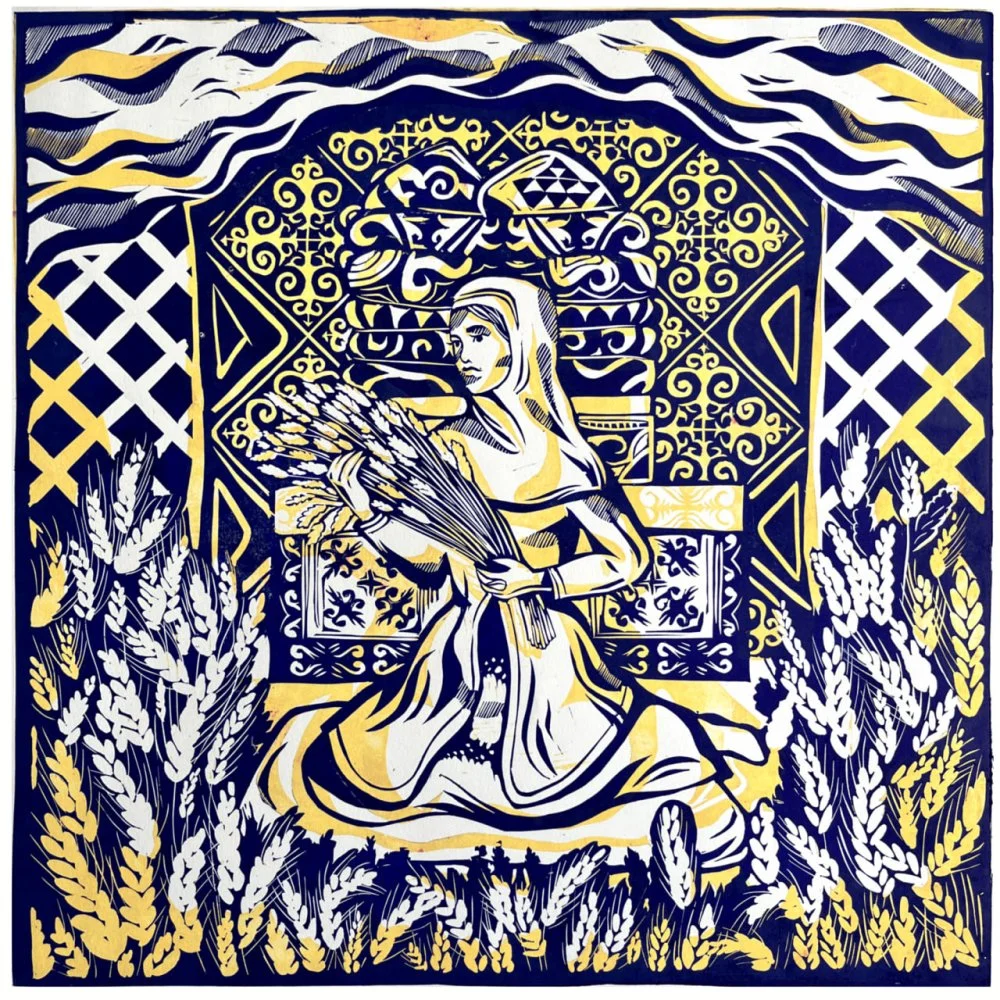
“Áiel segizi” series/Diana Akual
The Kazakhs placed great importance on a child's maternal lineage, recognizing its significant influence on character development. They sought brides from reputable families, believing that while a son's physical features and bone structurei
This belief is encapsulated in the proverb: ‘Üidiñ jaqsysy, ağaşynan, jıgıttıñ jaqsysy, nağaşydan’ (‘A yurt is considered good because of its wooden frame, and a man because of his maternal relatives’). Notably, among Siberian Turks, the word seok carries the dual meaning of both ‘bone’ and ‘lineage’, further emphasizing this connection. In addition, when a child displayed particular talents, such as musical or poetic abilities, it was commonly attributed to their nağaşy ata (maternal grandfather). This cultural perspective underscores the Kazakh emphasis on the maternal line in shaping a child's innate qualities and potential.
A child's character also depended on his mother's mood during her pregnancy and even before it. Therefore, everyone, from the husband to the mother-in-law, took care to ensure the young bride's happiness. After the wedding, the newlyweds, accompanied by an entourage, visited each relative in turn, with the bride adorned in her ceremonial saukele.i


The young bride was shielded from seeing or hearing anything unpleasant or burdensome, especially from being scolded. Therefore, even if her mother-in-law was displeased with something, she would address her daughter rather than the bride, as if directing her remark to her own daughter. This is reflected in the proverb ‘Qyzym, sağan aitamyn, kelınım, sen tynda’ (‘Daughter, I'm telling you, bride, you listen’). Considering that even unmarried daughters were spoiled and treated gently, it becomes evident that criticisms directed at the daughter were often indirectly aimed at the bride. These critiques were rare and were delivered in a gentle manner. The young bride was discouraged, especially if she was pregnant, to visit houses in mourning or from participating in funerals. It was believed that such experiences could potentially make the future child melancholic and predisposed to sadness.
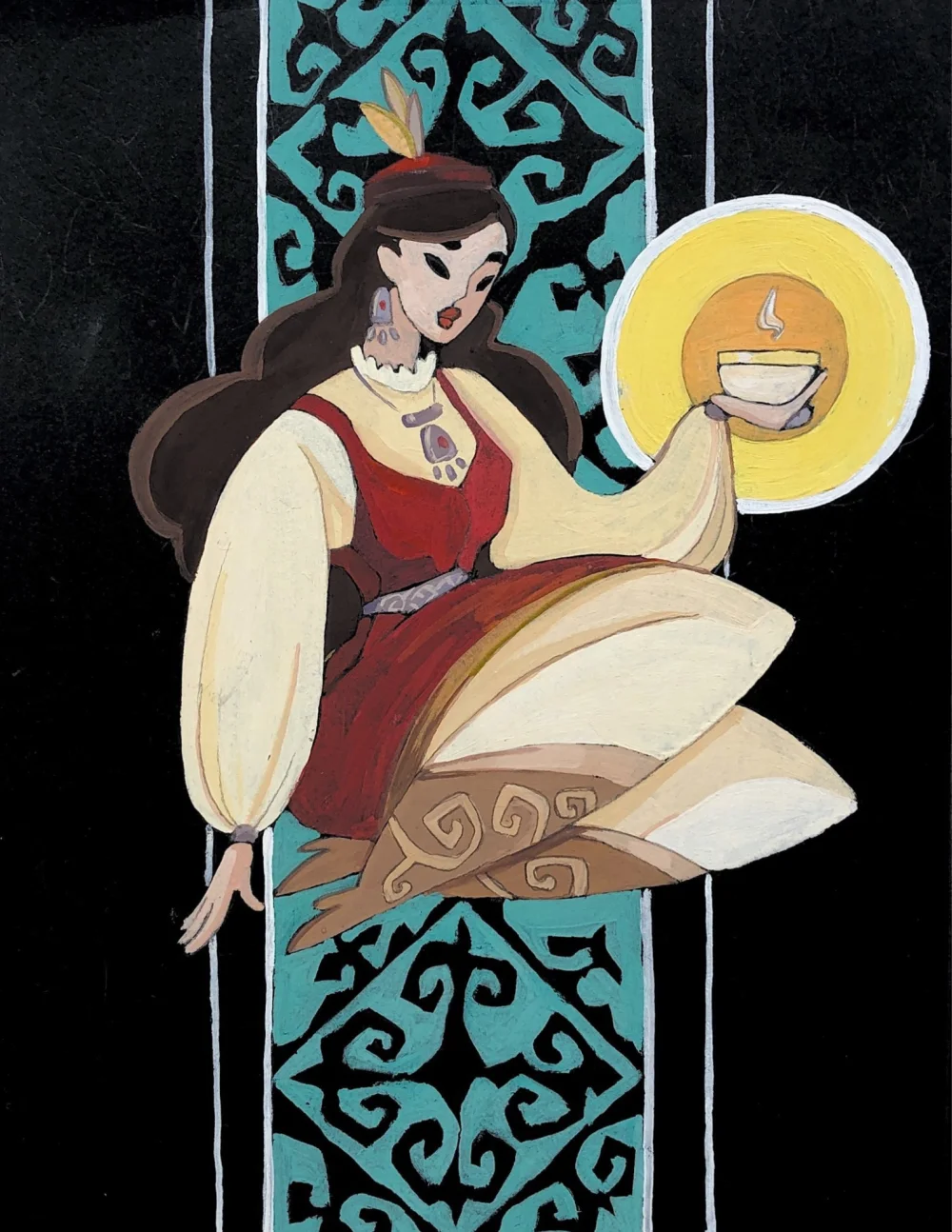
Beauty/Aidana Kulakhmetova
SEX IN A TRADITIONAL SOCIETY
In pastoral culture, everyone from childhood had a clear understanding of conception, which was not considered shameful but rather a blessed and sacred occurrence. During the Soviet era, there was an impression, sometimes portrayed by filmmakers, as we saw in the film Kelіn, that newlyweds would sleep in the same yurt as the elders, adolescents, and the rest of the family. In reality, a newlywed yurt (otau) was part of the bride's dowry and brought specifically for the couple to stay alone. Given that the father- and mother-in-law often adopted the eldest child, it is understandable that in the early years of marriage, young couples would sleep alone in their yurt or with their small children. The marital bed was traditionally situated on the left side of the yurt (if one was facing the tör, the honored place), known as the women's side, which was off-limits to male guests and enclosed by a curtain (şymyldyq). The marital bed was considered sacred, not only for sleeping but also for sitting.
In the nineteenth-century song ‘Gauhartas’, a man addresses his beloved and says: ‘I would be a sacrifice for the mother who gave birth to you’ (Anañ jatqan jerınen ainalaiyn). According to the expert on traditional culture, küishi, and writer Talasbek Asemkulov (1955–2014), these words originally were: ‘I would be a sacrifice for the place where your mother lay’ (Anań jatqan jerinen ainalaiyn), meaning ‘I would be a sacrifice for the bed where your mother conceived you.’ Today, these words might be perceived as crude or naturalistic, but for traditional Kazakhs, there was nothing shameful about sex within a legal marriage.
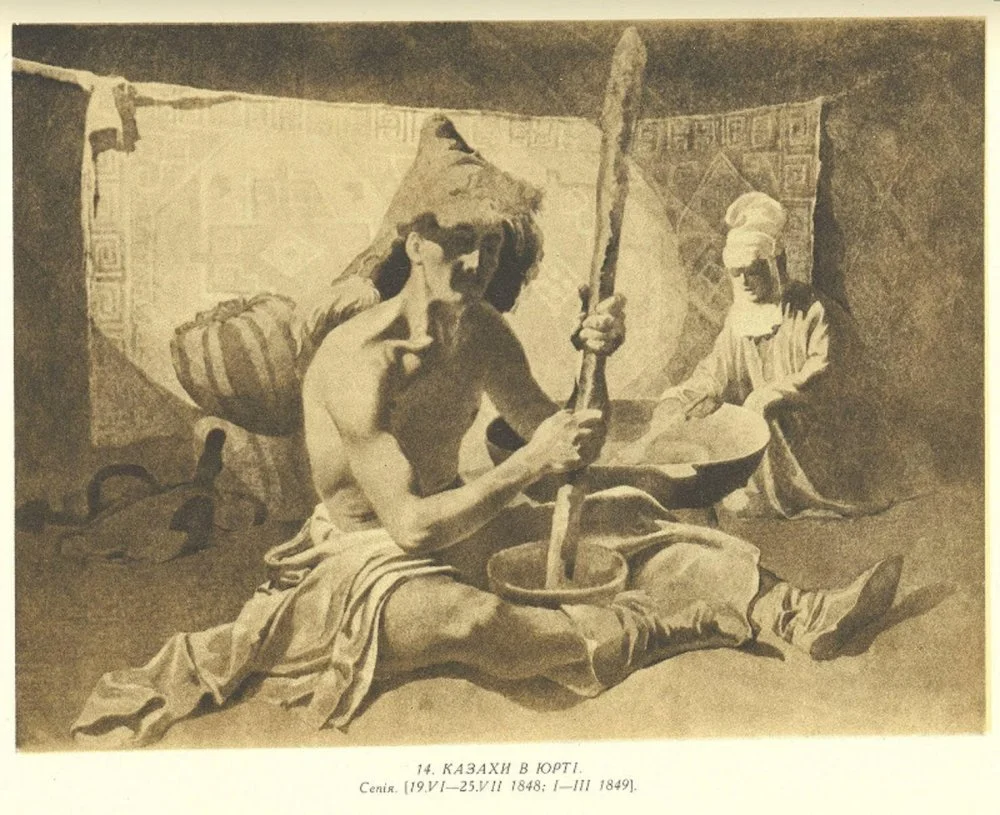
Taras Shevchenko. Kazakhs in yurt. 1849/Alamy
‘If spouses approach the act without soul or mood, then a son will be born without a member,’ (Köñılsızden kötsız tuady) proclaims a Kazakh proverb. Nowadays, the word ‘köt’ is typically translated as ‘rear end’ or ‘buttocks’, but it should be noted that metaphorically, it means ‘strength’ or ‘power’. Perhaps the proverb would seem less crude if we consider that köt is a phonetic variant of qūt, which is now understood as ‘happiness’, ‘fortune’, ‘prosperity’, ‘grace’ but originates from ancient mythological beliefs about the soul or embryo of a child or livestock descending from the celestial world into the human realm.
In Kazakh history, there are well-known batyrs with names like Kötıbar (meaning ‘possessing köt-qūt’) and Batyr Eset Kötıbarūly. Should this be considered a manifestation of phallocentrism? It's an interesting question for the future. However, one thing is clear—as the Kazakhs lose their traditional mentality, they distort even the concept of ūiat, or shame, and our folklore and linguistics become overly prudish and shy. Clearly, our ancestors were not like this.
HOW TO IMPRINT THE IMAGE OF THE HOMELAND IN AN INFANT
To ensure that future grandchildren are not kötsız, the mother-in-law and elder co-wives closely observed the mood of the young bride. For example, there is a significant episode in the historical novel Tättımbet Serı by Asemkulov, which portrays the life of a great composer in the nineteenth century. Pressured by his father, young Tättımbet rejected his first love and married a girl who had been betrothed to him. However, he fell into depression, and every night, partly because he was drunk from consuming too much aged kumis, he slept not next to his young wife but on the floor of the newlyweds’ yurt. Tättımbet's mother noticed the bride's subdued demeanor and sent elder co-wives to eavesdrop on the happenings in the otau at night. The revelation of her son's behavior was a shock to both her and her husband. Tättımbet's father called his son and, for the first time in his life, chastised him with the blow of a qamshy, explaining that his actions were disrespectful to his young wife and he needed to consider her feelings and dignity.
When the mother-in-law learned of her daughter-in-law's pregnancy, she organized the qūrsaq toi (meaning ‘the feast of the womb/uterus’) for the women (indeed, most rituals and celebrations related to childbirth were, naturally, for women). ‘Aq kelınnıñ qūrsağy aq airanğa tolypty’ (‘The womb of the white daughter-in-law has filled with white fermented milk’), she would say, comparing the daughter-in-law to the sacred leather bag saba, which personified the Great Mother. The goal was not just to announce the joyful news but also to share the blessing.

Kazakhs 19th century/Alamy
From the early days of her pregnancy, the young woman was given fresh, frothy mare's milk by her mother-in-law every morning. Dr Kanat Nurlanova, a doctor of philosophy, recounted the existence of this ritual among the Kazakhs. The Honored Artist of the Republic of Altai, director Tamara Mukanova-Mendosheva, in her autobiographical book Altai, Gold-Spined, with the Scent of Juniper, describes this ritual among Altai Turks: ‘To imprint in the child's heart this multifaceted, colorful, intimate, and sacred image of the homeland, so that with the mother's milk, he feels a blood-bound, inseparable connection to his native land, parents and close relatives performed a series of rituals: even in the mother's womb, he had to feel the scent of the native land. For this purpose, from the first days of pregnancy, the young woman was fed in the morning and evening with specially milked cow's or mare's milk, köörchek (a kind of oxygen cocktail): her child, growing up, willingly accepts in his heart the brilliance and beauty of the day, the secret mysteries of the night. This same drink was also given to babies to give them rosy cheeks.’
As we know, a pregnant woman could have food cravings, or jerik. These cravings were satisfied not only in epics but also in real life, even if they involved food that was normally considered taboo, such as wild boar meat. This was because the goal of all these efforts was the birth of a healthy, full-fledged child, a future member of the kinship group.

Engraved illustration of Eastern Siberia, Kirghiz (kazakh) Merchant at Semipalatinsk (steppe in northeast Kazakhstan)/Getty Images

